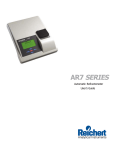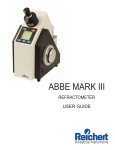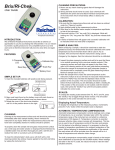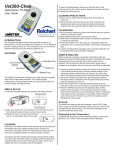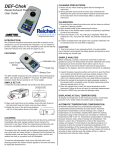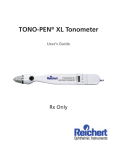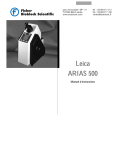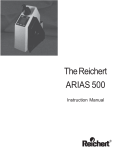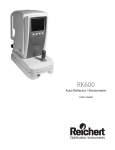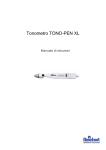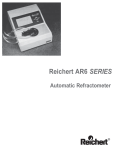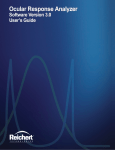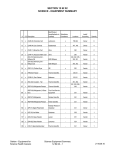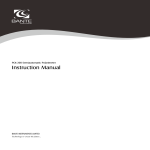Download AR200 Automatic Digital Refractometer User Guide
Transcript
AR200 Refractometer User’s Guide Page 1 Reichert AR200 Instruction Manual Table of Contents 1.0 2.0 3.0 4.0 5.0 6.0 7.0 8.0 9.0 10.0 11.0 12.0 13.0 Page 2 Page Introduction Specifications Environmental Conditions Care and Cleaning 4.1 Care of Prism Surface Instrument Features Automatic Temperature Compensation 6.1 Temperature coefficient and correction calculations Installation Procedure 7.1 Set Up Sample Reading Menu Options Daily Single Point Calibration Multipoint Calibration 11.1 Calibration Oils Channels 12.1 Channel 1 – Brix (Sucrose per ICUMSA) 12.2 Channels 2 – 4, User Programmable Accessories 3 4 5 5 5 6 7 7 7 8 10 11 12 13 14 15 15 15 15 1.0 INTRODUCTION Congratulations on your purchase of the Reichert AR200 Digital Handheld Refractometer. This manual describes the proper operation and care of this state of the art instrument. The AR200 is capable of measuring % Solids (Brix), % Solids-TC (Brix-Temperature Compensated), Refractive Index and Refractive IndexTC (temperature Compensated per ICUMSA Sucrose temperature Coefficient). Although it’s main purpose is to aid quality control personnel in Food and Beverage applications it’s advanced features make it a well suited instrument widely used for Medical, Pharmaceutical, Industrial Fluids, Chemical and Petrochemical Industries. An AR200 has the capability to measure Refractive Index (nD) of liquid solutions to a precision of +/0.0001or % Solids (Brix) to +/-0.1 with a range of 1.3300 to 1.5600nD and 0 to 95% Solids (Brix). Please note that an AR200 Refractometer is a high precision optical instrument. It is absolutely necessary to properly maintain the instrument to obtain the best possible accuracy. This includes thoroughly cleaning the prism and well after each sample and routinely calibrating the instrument. Always store the instrument with the well clean and dry. Page 3 2.0 SPECIFICATIONS · The Reichert AR200 operates on four AAA batteries. The instrument is capable of 3000+ readings on a set of batteries and has auto/off sleep mode after 30 seconds of inactivity and low battery detection. · · · · · · · · . Page 4 Three Key Operation: “CAL”, “READ” and “MENU” with on screen prompts. Illumination: 589 nm LED. Range: 1.3300 to 1.5600 Refractive Index (nD = 589nm Sodium D line). 0 to 95% Solids, (Brix-Sucrose per ICUMSA in Channel 1). User definable in channels 2 - 4. Readability: 0.0001 nD 0.1 % Solids. 0.1 oC Temperature Accuracy: +/-0.0001nD +/- 0.1% Solids (Brix), +/- 0.2oC Temperature. Temperature Compensation Range: 15o – 40oC (59o – 104o F) per ICUMSA in Channel 1, user definable in custom channels. Prism Assembly: Sapphire Prism sealed to Stainless Steel Well with solvent resistant epoxy. Dimensions: 18cm x 9cm x 3.5cm (7”L x 3.75”W x 1.37”D) Weight: 410g 3.0 ENVIROMENTAL CONDITIONS · Temperature Range: 10oC – 45oC · Max. Relative Humidity: 80% for temperatures to 31oC decreasing linearly to 50% (relative humidity at 40oC) · Pollution Degree 2 · Altitude up to 2,000 meters 4.0 CARE AND CLEANING The Reichert AR200 is a precision optical instrument. The prism surface and well should be cleaned immediately after use. The interior components are protected from dust, spills, and other damage. The stainless steel well and prism assembly is sealed with corrosion-resistant epoxy. All non-optical components can be cleaned with soap and water or methanol. Using strong solvents such as N, N-Dimethylformamide or N, N-Nimethylacetamide, cresols, phenols and other tar acids should be avoided, Tetrahydrofuran or some lacquer thinners and their components can also deteriorate the prism seal over time or when applied at elevated temperatures. Do not use Acetone, Acetone based products or other harsh solvents when cleaning the instrument’s body or it’s components. 4.1 CARE OF PRISM SURFACE The prism surface should be cleaned immediately after use. The use of strong acids or bases should not be measured with this instrument or used as cleaning agents. Do not use any metal or sharp objects to clean or pry loose the prism seal or residue on the sample or well. The sample should be wiped off with a moist tissue. Warm water and soap is recommended for removing sucrose residue and oil-based samples followed by a distilled water cleaning. Remove any remaining moisture with a dry tissue. Page 5 5.0 INSTRUMENT FEATURES Refer to the features listed below. 1. Instrument Display – Digitally displays measurement values, operator instructions and error messages. 2. Keypad Controls – All three controls are soft touch membrane keys, CAL/down, READ/up, MENU/ return. These keys serve a dual purpose as function keys and also facilitate moving the displayed cursor/ highlighter when selecting the many available options. · · · CAL – Prompts the user to perform a water calibration. Also is used as the “Down” key to allow scrolling when changing menu options or values. READ – Will read the sample in the well. Also is used as the “Up” key to scroll through choices when changing menu options and values. MENU – Allows entry to the menu options of the AR200. The menu key also functions as “Enter”, “Exit” or “Cancel” depending on the menu screen and/or the on screen instructions. 3. Sample Well – The sample well is made of Stainless Steel with a Sapphire Prism mounted to its center. When a sample is placed on the prism face, it is important that the sample cover the entire prism surface to attain an accurate reading. 4. IR Window – Located on the bottom of the AR200, it is used to communicate with your PC when cradled in the optional docking station. Page 6 6.0 AUTOMATIC TEMPERATURE COMPENSATION Automatic temperature compensation corrects readings over a range of temperatures. As an example: Samples taken at 15oC – 40oC are corrected to a reference temperature reading of 20oC. Temperature correction or control is necessary because refractive index varies inversely with temperature, as temperature of sample rises refractive index falls and so as sample temperature drops refractive index will rise. This feature can be used in lieu of controlling the temperature of the prism and sample. It is however necessary to Allow Samples to Temperature Equilibrate (sample must reach same temperature as prism surface) so that the AR200 can properly correct for temperature. The automatic temperature compensation mode built into the AR200 is based on the temperature coefficients ( ∆nD/∆oC) of sucrose, per the ICUMSA scales. When readings are taken in Index-TC (Refractive IndexTemperature Compensated) mode the reading is only valid for Sucrose (Brix) solutions. 6.1 Temperature Coefficient Calculations (non-Sucrose samples) Should you need to temperature correct refractive index values for samples other than those that are sucrose based. Please download “Temperature Coefficient Calculation and Temperature Correction” at www.reichert.com Analytical/Applications, or contact Reichert Analytical Technical Support ,716-686-4500. 7.0 INSTALLATION PROCEDURE A. Unpack instrument from carton. Retain packing material for future storage/protection/shipping. B. Please note the following accessories: Instruction Manual Batteries, four AAA Page 7 7.1 SET UP A. Turn the instrument over and remove the battery cover by rotating it in a counter clockwise direction. B. Install the four AAA batteries in the direction indicated. C. Reinstall the battery cover and turn instrument over. D. Place the instrument on a solid surface in an environment where the temperature is stable. Be sure to keep instrument away from heat or air conditioning vents, which can cause drafts and affect the temperature stability. Allow the instrument time to reach room temperature. E. Turn the AR200 on by pressing the “MENU” key. The title screen will appear followed by instructions to apply sample and press read. DO NOT, apply sample or press read at this time. Reichert AR200 Ver X.XX F. Select desired “Reading Mode” by pressing “MENU” key again to enter menu options. Exit Menu G. Use “READ” (Up) “CAL” (Down) keys to advance through mode options to “Reading Mode”, press the “MENU” (Return) key when you see the following screen. Reading Mode H. Page 8 Use the “UP” or “DOWN” keys to advance through “Reading” options, select “Brix – TC” mode for this exercise by highlighting and pressing the “RETURN” (MENU) key. “Brix – TC” % Solids – Temperature Compensated. “nD” Refractive Index. “Brix” % Solids. “nD – TC” Refractive Index – Temperature Compensated. Brix-TC I. You will then exit the menu screen and return to the main screen. Press “CAL” key and follow instructions to add sample, add “Distilled Water” as the sample. Enough distilled water should be added to cover the prism surface, approximately 3 drops. Allow sample to temperature equilibrate to prism/well. Press “CAL” key again. Observe the display for message indicating “Set Point Cal Successful”. Apply water CAL = Calibration MENU = Cancel Set point cal successful J. Press the “READ” key and note the value on the display, which should be “0.0 Brix-TC, 20.0o C”. Please note that the 0.0 Brix - TC reading can vary by +/ - 0.1 which is the acceptable tolerance of the AR200. 0.0 Brix - TC 20.0o C Page 9 8.0 SAMPLE READING A. Clean and dry the prism and well with a soft wipe, which will leave no residue and recommended cleaning agents, soap and warm water, Methanol or Isopropyl Alcohol followed by distilled water. B. Add enough of the sample to cover prism surface and allow adequate time for sample to temperature equilibrate to prism/well. C. Press “READ”. D. Note value on display. 1.3330 nD - TC 20.0o C E. Reference directions in “Set Up” section to switch between the four modes of measurement: 1. nD 2. Brix 3. nD - TC 4. Brix-TC F. Compare reading to known value. Note any difference in well temperature from sample reference temperature and adjust refractive index reading mathematically from the “Refractive Index” displayed value, reference section 6.1. Page 10 9.0 MENU OPTIONS A Exit Menu – Pressing the MENU key when this is displayed will exit the menu mode. B Calibration – Displays options of: 1. Set (water) - Pressing MENU will prompt to Apply Water and then “CAL” or “MENU” key to cancel. 2. Span 1.40229 – Press MENU will prompt to Apply 1.40229, NIST certified calibration oil and to press “CAL” or “MENU” key to cancel. 3. Span 1.51416 – Press MENU will prompt to Apply 1.51416, NIST certified calibration oil and to press “CAL” or “MENU” key to cancel. 4. Add/Delete/Edit – When selecting any of these modes a “Warning” will appear “Incorrect use of this function can corrupt the instrument”. Contact the Technical Support Group for a complete explanation if this function is to be used. 5. Exit - Press MENU to exit the calibration options mode. C Contrast – Press the MENU key to enter and the Up/ Down keys to adjust display contrast. D IR Linkup – To use this function the optional Docking Station (13951000) must be used. This feature allows for downloading of stored values, up to 225 of the most current readings and up to 5 point current calibration log. E Set Clock – Allows for setting of the time in 12 hour am/pm or 24 hour military and the date in MDY format. F Select Channel – This feature is visible only when at least one custom channel has been added to the AR200. Entering this feature allows the operator to switch between available channels/scales. G Reading Mode – Allows for changing between nD, nD-TC, Brix or Brix-TC reading modes. TC modes are Temperature Compensated based upon Sucrose data in channel 1. Page 11 10.0 DAILY SINGLE POINT CALIBRATION 1. Turn the instrument on by pressing the “CAL” key. 2. At the displayed message to apply sample, press the “Cal” key again. Exit Menu 3. Apply Distilled Water sample and Press the “CAL” key. Apply water CAL = Calibration MENU = Cancel 6. Set point cal successful message will appear if the AR200 is functioning properly. Set point cal successful Page 12 10.0 MULTIPOINT CALIBRATION The AR200 can be calibrated with up to 5 points using distilled water and 4 user definable points (note that these are set at the factory to match available NIST certified standards). Performing a 2 point calibration will provide the required accuracy needed, using distilled water and a high refractive index NIST certified standard. The AR200 has 3 points available as points that can be chosen through the calibration mode menu. Two additional points are available and modification of the existing points can also be done through the “Add/ Delete/Edit” option in the calibration menu. When entering this screen a message will appear “Warning, Incorrect use of this function can corrupt your instrument”. It is advisable to contact the technical support group before using this feature. The 3, 4 and 5, point calibrations is made available to allow the user to precisely calibrate the instrument to certified standards near the refractive index range where the measurements are being made. Reference the procedure below to perform the multipoint calibration. Always clean and dry the prism surface between the application of samples and be sure to proceed starting from the distilled water up to the sample with the highest refractive index. A. Turn the AR200 on by pressing the “MENU” key. B. Press the “MENU” key again after the startup screen appears to enter the Menu. C. Press the “UP” key until Calibration is read on the display and press the “MENU” key. D. When Set (Water) appears press the “MENU” key and follow the instructions on the display to add water and press the “CAL” key. E. Continue calibration process by repeating steps A through C and proceed to the next step. Page 13 F. When Set (Water) appears press the “UP” key several times to advance to the Span 1.51416 value, this value is given as an example and may be different, although close to the value on your AR200. Press the “MENU” key, other points exist. Span 1.51416 G. Follow the on screen instructions to apply “1.51416” sample, allow time for the sample to equilibrate and press “CAL” key. Apply 1.51416 CAL = Calibration MENU = Cancel H. To perform calibration of any additional points follow the procedure outlined in steps A through G making sure that you always start with the lowest refractive index sample and moving up to the highest refractive index sample. I. Clean and dry the prism surface and the AR200 will be ready to take readings. 11.1 CALIBRATION OILS The recommended Extended Precision Standard Calibration Oils are manufactured by Cargille Labs, Cedar Grove, NJ 07009-1289 USA, Phone 201-239-6633. To our knowledge they are the only domestic USA source of extended precision standard calibration oils with six significant figures in index. The characteristics of these oils are: • • • Page 14 NIST traceable. Stated accuracy at +/-0.00005 nD, shelf life in years. Temperature coefficients (TC) are guaranteed at their specified reference temperatures, usually 20 or 25oC. 12.0 13.0 CHANNELS 12.1 CHANNEL 1 – ICUMSA BRIX The AR200 is preprogrammed at the factory with channel 1 to read % Sucrose or “Brix” scale per the International Commission for Uniform Methods of Sugar Analysis (ICUMSA). Temperature Corrected (TC) readings in channel 1 are valid for Brix Solutions only! 12.2 CHANNEL 2 – 4, USER PROGRAMABLE User programmable scales or custom channels may be programmed at the factory or by using the optional IR communications package. Custom channels allow the user to use measurments specific to a solution to measure that solution and deliver readings with temperature correction factors that relate to that solution. ACCESSORIES Catalog No. 13951000 – IR Communications Package The IR Communications Package includes a docking station and the software required to connect the AR200 to your PC. It is useful for down loading stored readings, up to 225 of the most recent readings and up to 5 point current calibration log. Catalog No. 13K41330 Calibration Oil, 1.51432 Catalog No. 13K41340 Calibration Oil, 1.40229 Catalog No. 13K41350 Calibration Oil, 1.45755 Catalog No. 13K41360 Calibration Oil, 1.48989 Above values may vary due to supplier of oil. Page 15 Reichert Analytical Instruments Reichert, Inc. 3362 Walden Ave Depew, NY 14043 USA Toll Free: 888-849-8955 Phone: 716-686-4500 email: [email protected] www.reichert.com Reichert GmbH Hubertusstrasse 4 D-82229 Seefeld Germany Tel: +49-8152-993530 ISO-9001 Certified 13950000-100 Rev. F Page 16

















